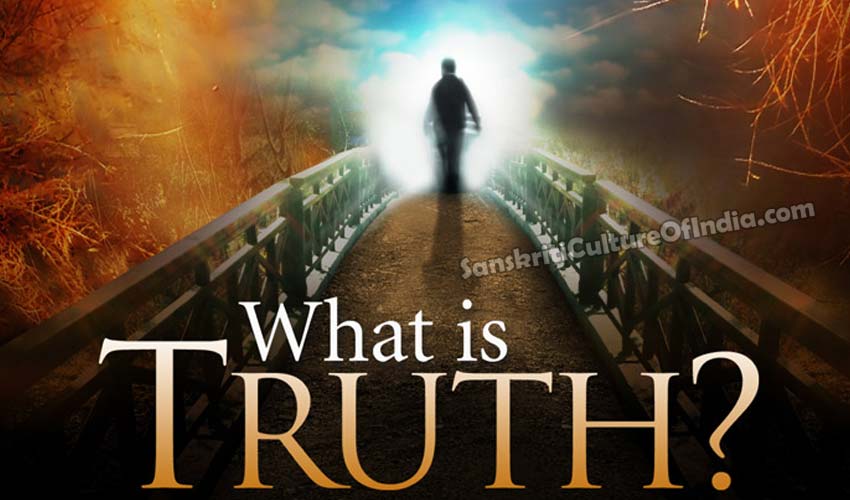“The non-existent has no existence; the existent does not not-exist. (Thus) the seers who have seen the essence of That reached the conclusion about the two.”
– The Bhagavadgita 2:16.
“It is neither born nor dies. At no time it did not non-exist in the past; will not non-exist in future; or will not become existence again. Unborn, eternal, permanent, and the most ancient, this is not killed when the body is killed.”
– The Bhagavadgita 2:20.
According to science, truth is what is provable either with logic or with facts or both. If you say something happened and if you witnessed it, you must be in a position to prove it even to those who did not see it. Even though it seems straightforward, in many cases it is not. Hence, not all the courts and laws in the world guarantee justice all the time. You are lucky if you are able to prove your point of view. You are also lucky if you are able to prove your scientific truths, because there are many truths that cannot be proved scientifically not because they are not true but because we do not have the wherewithal to prove them.
Characteristics of truth
From a philosophical perspective, in Hinduism truth must have some characteristics in order to be accepted as truth. Here are some important ones.
1. Truth must be universal. That is, it must be the same everywhere.
2. Truth must be indestructible or incorruptible. Truth must remain impervious to falsehood
3. Truth must be constant. Truth cannot change. If something keeps changing, it is difficult to prove its
existence.
4. Truth must be independent. Truth has to be self-existent and independent to qualify as truth. If it depends
upon another entity for its existence, it loses its autonomy, continuity, purity, invincibility and universality.
5. Truth must be the cause or the source, but not the effect. The effect depends upon the cause for its survival, composition and existence.
In our world, there are many aspects to truth. We consider truth either relative that is true in relation to something else or absolute that is true under all circumstances, independent of other things. There are eternal truths and temporary truths. Some truths are eternal. For example, from the scientific perspective, the space (as we know it) will exist eternally, even if the material world that exists in it is destroyed. May be, in reality, space is not what we consider it to be. It may be a type of element (tattva) or even matter (matra), which comes into existence at the time of the formation of the universe. If it is so, then space may not qualify as eternal. In Hinduism, space is considered an element (akasa), just like water, earth, fire and air.
Therefore, although space connects one world or planet with another and the earthly beings with the rest of the universe and although it facilitates the movement of prayers and sacred sounds as their medium, at some point of time in creation, it may end like everything else.
Nothing that falls within the domain of the mind and its faculties also qualify as absolute truth. The world exists in our minds as a concept and concepts are what they are, mere concepts. A hundred people may live in the same space and time and yet experience the world differently. Hindu scriptures therefore consider the phenomenal world as illusory and false, and hold only God and the Self as true. Satyam is that which contains
Sat or Truth. Sat is that which is true, constant, real, actual, not in a limited way, but wholly and eternally. According to the Upanishads, God or Brahman and the individual Self alone qualify to be That, which is everlasting and absolutely true.
Standards of proof
Ancient Indians established some standards (pramana) to ascertain truths of our existence. The most prominent among them are inference (anumana). Of them, we may consider the first one reliable by itself, the second useful for corroboration or confirmation and the third no so reliable, but helpful on certain occasions. Pratyaksha is what we may perceive or experience directly and personally. It is therefore somewhat reliable, although we cannot take our experiences for granted fully. We may consider our direct experiences valid in case of general and ordinary truths.
However, we should also be aware of defective perceptions and perceptual biases to which our minds and senses are susceptible. We know that our senses and our minds are not perfect instruments of knowledge. What we see may not be true and what we do not see may not be false. It is as if we live in a world of fog and mist, which is our own ignorance. We may see what we want to see or see it differently from what it actually is, or see it incorrectly, or not see it at all. We may mistake one for another. We may also see or experience something but not recognize it at all because we have never experienced it before or know nothing about it.
Therefore, while direct experience is helpful, we have to be careful about what conclusions and observations we may draw from it. This is where the testimony of the scriptures and the accounts of experts prove helpful. If our direct experience is validated by the testimony of scriptures or expert knowledge, we can accept them as more reliable and accurate, although there may still be issues that need to be resolved and gaps in our understanding and awareness that need to be filled.











